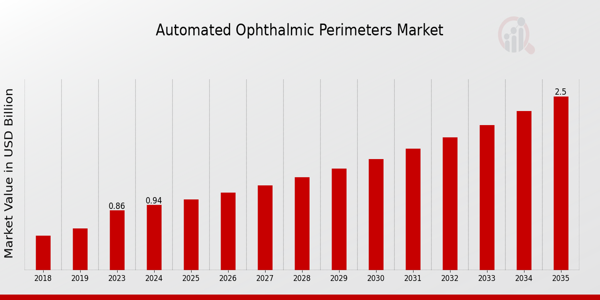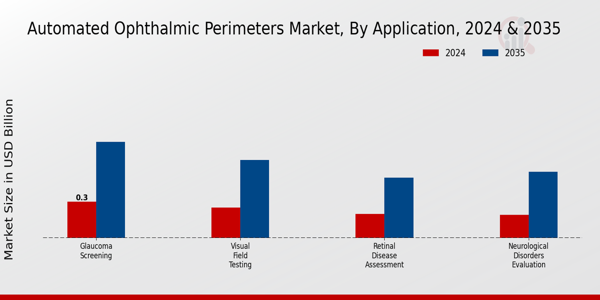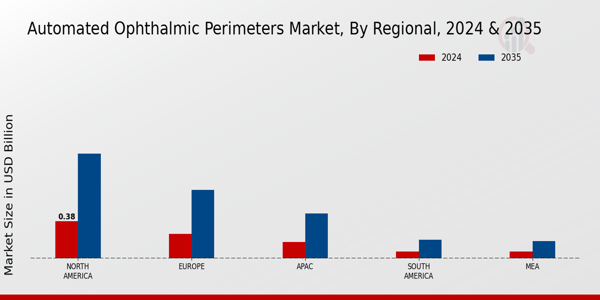Automated Ophthalmic Perimeters Market Overview
As per MRFR analysis, the Automated Ophthalmic Perimeters Market Size was estimated at 0.86 (USD Billion) in 2023.The Automated Ophthalmic Perimeters Market is expected to grow from 0.94(USD Billion) in 2024 to 2.5 (USD Billion) by 2035. The Automated Ophthalmic Perimeters Market CAGR (growth rate) is expected to be around 9.33% during the forecast period (2025 - 2035).
Key Automated Ophthalmic Perimeters Market Trends Highlighted
The Global Automated Ophthalmic Perimeters Market is experiencing significant growth driven by an increasing prevalence of eye diseases such as glaucoma and macular degeneration. The rising aging population is another key driver, as older individuals are more susceptible to these conditions, leading to a greater demand for effective diagnostic tools. Additionally, advancements in technology are enhancing the efficiency and accuracy of automated perimetry devices, making them more appealing to healthcare providers. The integration of artificial intelligence into these systems is an exciting avenue, improving data analysis and patient outcomes. There are numerous opportunities to be explored in this market.
Increasing awareness about eye health is driving more patients to seek regular check-ups, which in turn creates a larger market for ophthalmic equipment. Furthermore, the expansion of telemedicine allows for remote eye examinations, increasing accessibility to automated perimeter technology even in underserved areas.
Investment in research and development can lead to innovative products that cater to specific healthcare needs, offering companies a chance to capture unmet market demands. Recent trends indicate a shift towards user-friendly devices that can be easily operated by healthcare professionals of varying skill levels.
This simplification allows for more widespread adoption in both clinical and outpatient settings. Moreover, there is a growing trend to focus on patient-centric designs that enhance the user experience, making the process less intimidating for patients.
As digital health technology continues to evolve, interconnected devices that allow for seamless data sharing between patients and healthcare providers are becoming essential, pointing towards a more integrated approach to ophthalmic care.

Source: Primary Research, Secondary Research, MRFR Database and Analyst Review
Automated Ophthalmic Perimeters Market Drivers
Increase in Prevalence of Eye Diseases
The Global Automated Ophthalmic Perimeters Market is witnessing significant growth due to the increasing prevalence of eye diseases globally. As populations age, the incidence of conditions such as glaucoma, diabetic retinopathy, and macular degeneration has become more common.
With the rise in the number of individuals experiencing vision-related issues, there is a growing need for advanced diagnostic tools that can provide accurate assessments of visual field damage. Automated ophthalmic perimeters have become essential in the early detection and management of these conditions, enhancing the quality of patient care and improving clinical outcomes.
The ongoing advancements in technology have further improved the capabilities and ease of use of these devices, making them indispensable in ophthalmology practices. With the anticipation of growing investments in healthcare infrastructure and increasing awareness among the public regarding eye health, the demand for automated perimeter devices is set to rise significantly.
This trend is likely to persist in the foreseeable future, particularly as healthcare organizations seek to enhance their diagnostic capabilities to handle the rising burden of eye diseases.
Technological Advancements
Technological advancements play a crucial role in driving the growth of the Global Automated Ophthalmic Perimeters Market. Innovations in imaging techniques, data processing, and user interface design have significantly enhanced the functionality and accuracy of automated perimeters.
These advancements allow for more detailed visual field assessments and enable practitioners to make better-informed decisions regarding patient care. Continuous improvements in device design and software integration also contribute to streamlined workflows in clinical settings, which translates to enhanced patient experiences and outcomes.
As healthcare providers increasingly adopt cutting-edge technology to improve diagnostic accuracy, automated ophthalmic perimeters stand out as a vital component in the delivery of high-quality ophthalmic care.
Growing Awareness and Importance of Regular Eye Check-ups
There is a growing awareness among the populace regarding the significance of regular eye check-ups, which significantly contributes to the growth of the Global Automated Ophthalmic Perimeters Market. Educational campaigns and initiatives aimed at promoting eye health have underscored the importance of early detection and intervention for various eye diseases.
As individuals become more conscious of their eye health, this increased awareness drives demand for comprehensive eye examinations, where automated perimeters play a pivotal role. The shift towards preventive healthcare and the emphasis on early diagnosis of vision disorders ensure a steady increase in the utilization of automated ophthalmic perimeter devices in clinical settings.
Automated Ophthalmic Perimeters Market Segment Insights
Automated Ophthalmic Perimeters Market Application Insights
The Global Automated Ophthalmic Perimeters Market focused on various applications that played a crucial role in diagnosing and monitoring eye-related conditions.
In 2024, the market's segmentation revealed distinct values across different applications, with Glaucoma Screening standing out as a significant area of focus, valued at 0.3 USD Billion in 2024, which is expected to rise to 0.8 USD Billion by 2035. This segment held a major position due to the rising prevalence of glaucoma, necessitating regular screening for early detection and better treatment outcomes.
Visual Field Testing, another key application, accounted for a value of 0.25 USD Billion in 2024 and is expected to increase to 0.65 USD Billion by 2035, reflecting the critical need for assessing visual functions and identifying changes that may indicate various ocular conditions.
Meanwhile, Retinal Disease Assessment generated a market valuation of 0.2 USD Billion in 2024, growing to 0.5 USD Billion by 2035, highlighting its essential role in detecting retinal disorders that could lead to vision loss if not addressed timely.
Neurological Disorders Evaluation also contributed to the market, with an initial value of 0.19 USD Billion in 2024, projected to rise to 0.55 USD Billion by 2035, showing significance in linking eye health to neurological conditions that required comprehensive assessment.
The segment's growth is driven by technological advancements in automated perimetry devices, increasing awareness regarding eye health, and a growing elderly population susceptible to vision-related disorders.
As a whole, the Global Automated Ophthalmic Perimeters Market data indicated robust growth potential, shaped by evolving healthcare policies and a focus on effective diagnostic tools. Overall, the segmentation demonstrated a market landscape defined by diverse applications, each catering to crucial health needs and driving the ongoing development of ophthalmic technologies.

Source: Primary Research, Secondary Research, MRFR Database and Analyst Review
Automated Ophthalmic Perimeters Market End Use Insights
The Global Automated Ophthalmic Perimeters Market is poised for growth across its various end-use applications, with hospitals, ophthalmology clinics, and research and academic institutions playing pivotal roles in shaping this landscape.
Hospitals are significant contributors, where a large patient base and need for comprehensive eye examinations drive market demand. Ophthalmology clinics also play a crucial role, specializing in eye health and offering tailored diagnostics that optimize patient care.
Furthermore, research and academic institutions contribute to the market by innovating new technologies and methodologies, enhancing understanding of visual field testing.
These end-use categories demonstrate a variety of needs and opportunities within the Global Automated Ophthalmic Perimeters Market, emphasizing the importance of accessibility, technological advancements, and specialized care in addressing eye health challenges.
The overall market growth is supported by these segments, revealing essential data on how healthcare landscapes are evolving to manage vision-related issues more effectively.
Automated Ophthalmic Perimeters Market Product Type Insights
The growth is driven by the rising prevalence of ocular diseases and increasing demand for advanced diagnostic solutions. The market segmentation reveals distinct types of products, including Static Perimeters, Kinetic Perimeters, and Electrophysiological Perimeters, each playing a critical role in eye care.
Static Perimeters are significant for their precision and ease of use, making them essential in clinical settings for diagnosing conditions such as glaucoma. Kinetic Perimeters dominate the segment due to their ability to assess visual fields under dynamic conditions, providing a comprehensive understanding of a patient’s field of vision.
Electrophysiological Perimeters are pivotal for measuring retinal responses and enhancing the diagnostic capabilities for various retinal diseases. These product types collectively contribute to improved patient outcomes, signifying their importance within the Global Automated Ophthalmic Perimeters Market.
Factors such as technological advancements and the growing geriatric population further enhance market growth, presenting substantial opportunities for stakeholders in this sector.
Automated Ophthalmic Perimeters Market Operating Mode Insights
Within this market, the Operating Mode segment plays a crucial role, classified primarily into Automated and Semi-Automated categories. Automated systems are increasingly becoming preferred due to their efficiency, accuracy, and reduced need for extensive training, catering to a growing demand for streamlined processes in eye care.
The Semi-Automated segment also retains significance, as it combines user involvement and automation, making it essential for integrations where precision and user input are necessary. The ongoing advancements in technology further empower these segments, addressing consumer needs for quality diagnostic tools while presenting a considerable opportunity for market growth.
Emerging trends indicate that the shift towards more automated solutions will enhance the capabilities within the Global Automated Ophthalmic Perimeters Market, setting the stage for continued innovation and development.
Automated Ophthalmic Perimeters Market Regional Insights
The Global Automated Ophthalmic Perimeters Market was diverse across various regions, showcasing significant revenue generation potential. In 2024, North America led with a valuation of 0.38 USD Billion, projected to grow to 1.07 USD Billion by 2035, highlighting its majority holding in the market driven by advanced healthcare infrastructures and increasing incidence of eye disorders.
Europe followed with a valuation of 0.25 USD Billion in 2024, expected to reach 0.70 USD Billion by 2035, indicating its pivotal role in adopting innovative ophthalmic solutions. The APAC region, valued at 0.17 USD Billion in 2024 and forecasted to grow to 0.46 USD Billion by 2035, was significant due to its rapidly expanding population and rising awareness regarding eye health.
South America and MEA, valued at 0.07 USD Billion and 0.07 USD Billion respectively in 2024, are anticipated to grow to 0.19 USD Billion and 0.18 USD Billion by 2035, but remained smaller segments, reflecting emerging market dynamics and developing healthcare systems.
Overall, the Global Automated Ophthalmic Perimeters Market segmentation illustrated pronounced growth opportunities across regions influenced by healthcare trends and technological advancements.

Source: Primary Research, Secondary Research, MRFR Database and Analyst Review
Automated Ophthalmic Perimeters Market Key Players and Competitive Insights :
The Global Automated Ophthalmic Perimeters Market has seen significant growth driven by advancements in technology and an increasing demand for efficient diagnostic tools in the field of ophthalmology.
The competitive landscape is characterized by a push towards innovation, with companies emphasizing features such as enhanced accuracy, user-friendly interfaces, and integration capabilities with other diagnostic equipment.
As the awareness of eye health continues to rise globally, medical practitioners and hospitals are actively seeking automated solutions that provide quick and reliable results for visual field testing.
The market is shaped by a variety of factors including regulatory changes, technological advancements, and shifting consumer preferences, ultimately influencing how companies position themselves within this evolving ecosystem.
DigitalOptometrics has established a strong presence in the Global Automated Ophthalmic Perimeters Market by focusing on the development of cutting-edge perimeter solutions that enhance patient care and streamline the testing process.
The company's strengths include its commitment to research and development, thereby enabling it to introduce innovative technologies that offer precise visual field testing results. DigitalOptometrics is recognized for its robust customer support and training programs, which help eye care professionals effectively utilize their systems leading to improved patient outcomes.
Furthermore, the company has successfully leveraged partnerships and collaborations within the industry to enhance its market reach and provide integrated solutions that cater to a variety of healthcare settings.
Sonomed Escalon remains a formidable player in the Global Automated Ophthalmic Perimeters Market, known for its wide range of products that address various aspects of eye care diagnostics. The company's strength lies in its dedication to delivering high-quality, reliable equipment that meets rigorous industry standards.
Sonomed Escalon is notable for its emphasis on customer-centric solutions, with advanced perimeter systems that incorporate user-friendly interfaces and robust data management capabilities. By investing in its technological infrastructure and maintaining a focus on clinical efficiency, Sonomed Escalon is positioned to meet the growing demands of healthcare providers seeking advanced diagnostics tools.
Their long-standing expertise and reputation in the ophthalmic market further solidify their competitive edge, allowing them to effectively serve a diverse client base.
Key Companies in the Automated Ophthalmic Perimeters Market Include:
- DigitalOptometrics
- Sonomed Escalon
- Nidek
- Reichert Technologies
- Gauss Surgical
- Topcon
- Kowa
- Carl Zeiss
- Rsket Technologies
- Centervue
- Heidelberg Engineering
- EssilorLuxottica
- Optometry Limited
- Optovue
- Mirante
Automated Ophthalmic Perimeters Market Developments
Recent developments in the Global Automated Ophthalmic Perimeters Market indicate a growing interest in advanced technologies that enhance patient care and diagnostics. Companies such as DigitalOptometrics and Topcon have introduced innovative automated perimetry solutions to improve accuracy and efficiency in eye examinations.
Nidek and Carl Zeiss are also focusing on integrating artificial intelligence and machine learning capabilities into their devices, enhancing diagnostic precision. Furthermore, recent mergers and acquisitions, including those involving Sonomed Escalon and Reichert Technologies, have reshaped the competitive landscape, allowing these companies to broaden their product offerings and market reach.
Market valuation for firms like Heidelberg Engineering and Optovue has seen significant growth, driven by rising demand for non-invasive testing methods and an increase in eye-related disorders globally. This increase is also supported by advancements in technology that streamline workflows in clinical settings.
Companies like Gauss Surgical and Centerville are expanding their portfolios in collaboration with healthcare providers, while EssilorLuxottica's acquisition strategies bolster its position in the ophthalmic sector. Overall, these dynamic changes are indicative of a rapidly evolving market landscape aimed at improving patient outcomes in vision care.
Automated Ophthalmic Perimeters Market Segmentation Insights
Automated Ophthalmic Perimeters Market Application Outlook
- Glaucoma Screening
- Visual Field Testing
- Retinal Disease Assessment
- Neurological Disorders Evaluation
Automated Ophthalmic Perimeters Market End Use Outlook
- Hospitals
- Ophthalmology Clinics
- Research and Academic Institutions
Automated Ophthalmic Perimeters Market Product Type Outlook
- Static Perimeters
- Kinetic Perimeters
- Electrophysiological Perimeters
Automated Ophthalmic Perimeters Market Operating Mode Outlook
Automated Ophthalmic Perimeters Market Regional Outlook
- North America
- Europe
- South America
- Asia Pacific
- Middle East and Africa
| Attribute/Metric Source: |
Details |
| MARKET SIZE 2023 |
0.86(USD Billion) |
| MARKET SIZE 2024 |
0.94(USD Billion) |
| MARKET SIZE 2035 |
2.5(USD Billion) |
| COMPOUND ANNUAL GROWTH RATE (CAGR) |
9.33% (2025 - 2035) |
| REPORT COVERAGE |
Revenue Forecast, Competitive Landscape, Growth Factors, and Trends |
| BASE YEAR |
2024 |
| MARKET FORECAST PERIOD |
2025 - 2035 |
| HISTORICAL DATA |
2019 - 2024 |
| MARKET FORECAST UNITS |
USD Billion |
| KEY COMPANIES PROFILED |
DigitalOptometrics, Sonomed Escalon, Nidek, Reichert Technologies, Gauss Surgical, Topcon, Kowa, Carl Zeiss, Rsket Technologies, Centervue, Heidelberg Engineering, EssilorLuxottica, Optometry Limited, Optovue, Mirante |
| SEGMENTS COVERED |
Application, End Use, Product Type, Operating Mode, Regional |
| KEY MARKET OPPORTUNITIES |
Growing demand for early diagnosis, Advancements in AI technology integration, Increasing prevalence of eye diseases, Rising geriatric population globally, Expansion of telemedicine services |
| KEY MARKET DYNAMICS |
Technological advancements in ophthalmology, Increasing prevalence of eye disorders, Growing geriatric population, Rising adoption of home healthcare, Enhanced accuracy and efficiency |
| COUNTRIES COVERED |
North America, Europe, APAC, South America, MEA |
Frequently Asked Questions (FAQ) :
The expected market size of the Global Automated Ophthalmic Perimeters Market in 2024 is valued at 0.94 USD Billion.
The projected market value of the Global Automated Ophthalmic Perimeters Market by 2035 is 2.5 USD Billion.
The anticipated CAGR for the Global Automated Ophthalmic Perimeters Market from 2025 to 2035 is 9.33%.
By 2035, North America is expected to hold the largest market share with a value of 1.07 USD Billion.
The market size for Glaucoma Screening in 2024 is valued at 0.3 USD Billion.
Some key players in the Global Automated Ophthalmic Perimeters Market include DigitalOptometrics, Nidek, and Carl Zeiss.
The expected market size for Visual Field Testing in 2035 is 0.65 USD Billion.
In 2024, the Automated Ophthalmic Perimeters Market in APAC is valued at 0.17 USD Billion.
The market size for Neurological Disorders Evaluation by 2035 is projected to be 0.55 USD Billion.
The market value for Retinal Disease Assessment in 2024 is 0.2 USD Billion.

















